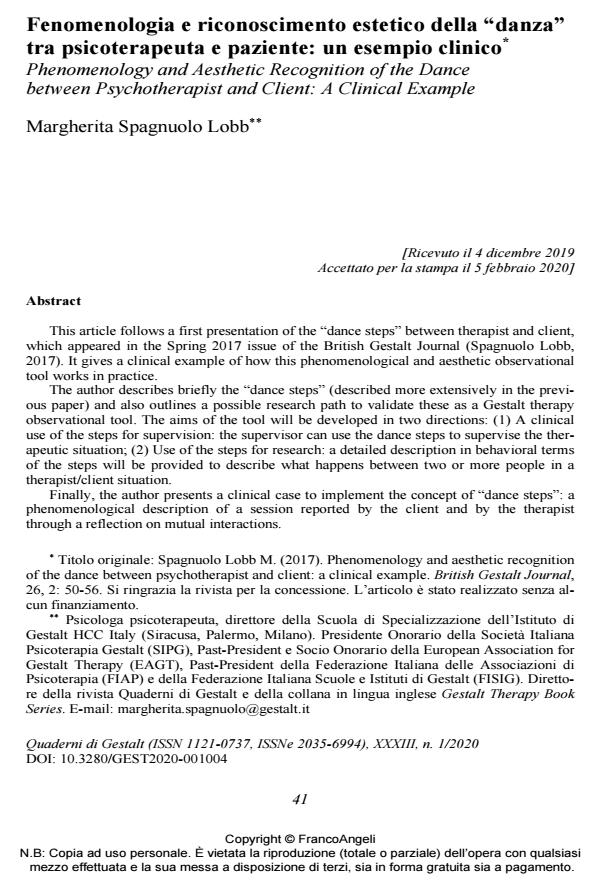Phenomenology and Aesthetic Recognition of the Dance between Psychotherapist and Client: A Clinical Example
Journal title QUADERNI DI GESTALT
Author/s Margherita Spagnuolo Lobb
Publishing Year 2020 Issue 2020/1
Language Italian Pages 16 P. 41-56 File size 201 KB
DOI 10.3280/GEST2020-001004
DOI is like a bar code for intellectual property: to have more infomation
click here
Below, you can see the article first page
If you want to buy this article in PDF format, you can do it, following the instructions to buy download credits

FrancoAngeli is member of Publishers International Linking Association, Inc (PILA), a not-for-profit association which run the CrossRef service enabling links to and from online scholarly content.
This article follows a first presentation of the "dance steps" between therapist and client, which appeared in the Spring 2017 issue of the British Gestalt Journal (Spagnuolo Lobb, 2017). It gives a clinical example of how this phenomenological and aesthetic observational tool works in practice. The author describes briefly the "dance steps" (described more extensively in the previous paper) and also outlines a possible research path to validate these as a Gestalt therapy observa-tional tool. The aims of the tool will be developed in two directions: (1) A clinical use of the steps for supervision: the supervisor can use the dance steps to supervise the therapeutic situa-tion; (2) Use of the steps for research: a detailed description in behavioral terms of the steps will be provided to describe what happens between two or more people in a therapist/client situation. Finally, the author presents a clinical case to implement the concept of "dance steps": a phenomenological description of a session reported by the client and by the therapist through a reflection on mutual interactions. The context of the work is a Summer Program that takes place every year at the end of Ju-ly in Syracuse, Italy: a five-day retreat for psychotherapists from all over the world, with the main aim of taking care of themselves whilst also receiving theoretical and clinical updates. One of the participants describes what she remembered of the session and then the therapist adds her experience. The recollection is live and most of all it recounts the perception of the client and that of the therapist, in "dance steps" terms. It is Gestalt therapy work on a dream, which they have called "the wolf work". The author concludes connecting the use of reciproci-ty to political and social response-ability today. A main clinical problem today derives from the lack of recognition from the other, which makes bodily desensitization evident in our clients. This brings Gestalt therapists to focus on the reciprocity of their interactions with clients, in-stead of on how only the client makes contact. As a matter of fact, in the actual dance between them there is the possibility of revitalizing the contact boundary, where the self is co-created.
Keywords: Therapist/client dance steps, phenomenology, aesthetics, desensitisation, reciprocity.
- La supervisione in psicoterapia della Gestalt Margherita Spagnuolo Lobb, in QUADERNI DI GESTALT 1/2024 pp.7
DOI: 10.3280/qg2024-1oa17950
Margherita Spagnuolo Lobb, Fenomenologia e riconoscimento estetico della "danza" tra psicoterapeuta e paziente: un esempio clinico in "QUADERNI DI GESTALT" 1/2020, pp 41-56, DOI: 10.3280/GEST2020-001004